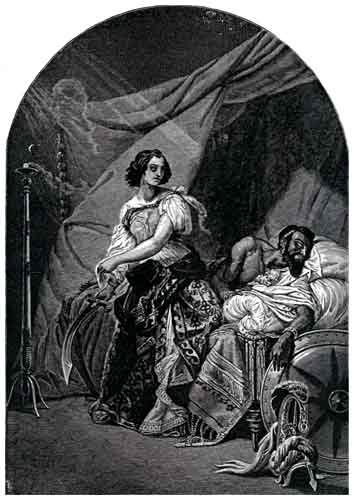 |
 |
 |
|
|
Judith and Holofernes
From the picture by Emile-Jean-Horace Vernet.
|
...introduction continued; EMILE-JEAN-HORACE VERNET has been
already mentioned among the French military painters. He was born is
Paris, in 1789, in the Louvre, where his parents had an apartment, and
he died so late as 1863. His grandfather, Joseph Vernet, was a marine-painter
of distinction in his time, although his works are long out-grown, but
he did something, perhaps, to break the spell of the old classic formulas,
and thus entitled his work to respectful consideration. Horace Vernet was for
a long time one of the most popular artists in France; he held the place he had
gained when he was but a youth, by the lavish way in which he put his
art at the service of the French love of military glory, since the greater
part of his five hundred pictures are the record of French victories
and triumphs. The battles of Napoleon, the conquest of Algiers, gave
him subjects in plenty, and the long galleries at Versailles, filled
with the fulsome record of these wars, are known to weariness by the
visitors whose feet have tramped through them. All that gives Vernet
a right to be remembered is the fact that he was one of the first to
put into his battle-pieces something of that life which we of to-day
recognize and applaud in the pictures of the men whom we count among
the true battle painters. But his art was in itself superficial and
uninteresting, and the contents of his pictures more superficial and
uninteresting still, and the picture we have selected to illustrate
our note is perhaps the only one that retains any hold upon the public
that does not care for the military triumphs of France. Another picture,
"Rebecca at the Well" has also been engraved and long enjoyed
a certain popularity. Both the "Judith about to slay Holofernes"
and the "Rebecca" were painted in Algiers, where Vernet had
joined the French army. The "Rebecca" was one of the first
pictures painted in our times, in which the idea was embodied, that
since the manners and customs of the East have remained with little
change down to our own day, the people of the Bible may properly be
represented dressed in the Oriental costumes of the present time. The
suggestion of the "Judith" grew naturally enough out of the
new familiarity with things of the East, with stuffs and rugs, and arms
and armor, and with the dark-skinned people themselves, since all that
the ordinary artist asks for his picture is a subject on which he can
utilize the "properties" he has at command. We may mention,
in passing, that the original study of the head and bust of the model
who sat for the Judith, was lately sold at auction here in New York,
and, as often happens, it was, as a study, far more interesting than
the head in the completed picture. continued... |
